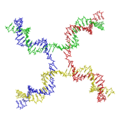DNA nanotechnology
DNA Nanotechnology
DNA nanotechnology is a branch of nanotechnology that uses the unique molecular recognition properties of DNA and other nucleic acids to create self-assembling nanostructures. This field exploits the predictable base pairing rules of DNA to design and construct complex structures at the nanoscale.
History
The concept of DNA nanotechnology was first introduced by Nadrian Seeman in the early 1980s. Seeman proposed using DNA to create a lattice for organizing other molecules, which laid the foundation for the development of this field.
Principles
DNA nanotechnology relies on the specific base pairing interactions between adenine (A) and thymine (T), and between cytosine (C) and guanine (G). These interactions allow for the precise design of DNA strands that can self-assemble into predetermined structures.
Applications
DNA nanotechnology has a wide range of applications, including:
- **Molecular Computing**: DNA can be used to perform computations by encoding information in the sequence of bases.
- **Drug Delivery**: DNA nanostructures can be designed to carry and release therapeutic agents in a controlled manner.
- **Biosensing**: DNA-based sensors can detect specific molecules or changes in the environment.
- **Structural Biology**: DNA nanostructures can be used to organize proteins and other biomolecules for structural studies.
Techniques
Some of the key techniques used in DNA nanotechnology include:
- **DNA Origami**: A method where a long single strand of DNA is folded into a specific shape with the help of short "staple" strands.
- **Tile-based Assembly**: Uses small DNA tiles that can self-assemble into larger structures.
- **Hybridization Chain Reaction**: A technique where DNA strands undergo a chain reaction of hybridization to form long chains.
Challenges
Despite its potential, DNA nanotechnology faces several challenges, such as:
- **Stability**: DNA structures can be sensitive to environmental conditions such as temperature and pH.
- **Scalability**: Creating large and complex structures can be difficult and resource-intensive.
- **Cost**: The synthesis of custom DNA sequences can be expensive.
Future Directions
Research in DNA nanotechnology is ongoing, with efforts focused on improving the stability and scalability of DNA structures, as well as expanding their applications in medicine and materials science.
References
External Links
- [DNA Nanotechnology at Wikipedia](https://en.wikipedia.org/wiki/DNA_nanotechnology)
- [Nadrian Seeman's Research Group](http://seemanlab4.chem.nyu.edu/)
Lua error in package.lua at line 80: module 'strict' not found.
| Molecular biology | ||||||||||||||||||||
|---|---|---|---|---|---|---|---|---|---|---|---|---|---|---|---|---|---|---|---|---|
|
- Escher Depth.jpg
Escher Depth
Transform your life with W8MD's budget GLP-1 injections from $125.
W8MD offers a medical weight loss program to lose weight in Philadelphia. Our physician-supervised medical weight loss provides:
- Most insurances accepted or discounted self-pay rates. We will obtain insurance prior authorizations if needed.
- Generic GLP1 weight loss injections from $125 for the starting dose.
- Also offer prescription weight loss medications including Phentermine, Qsymia, Diethylpropion, Contrave etc.
NYC weight loss doctor appointments
Start your NYC weight loss journey today at our NYC medical weight loss and Philadelphia medical weight loss clinics.
- Call 718-946-5500 to lose weight in NYC or for medical weight loss in Philadelphia 215-676-2334.
- Tags:NYC medical weight loss, Philadelphia lose weight Zepbound NYC, Budget GLP1 weight loss injections, Wegovy Philadelphia, Wegovy NYC, Philadelphia medical weight loss, Brookly weight loss and Wegovy NYC
|
WikiMD's Wellness Encyclopedia |
| Let Food Be Thy Medicine Medicine Thy Food - Hippocrates |
Medical Disclaimer: WikiMD is not a substitute for professional medical advice. The information on WikiMD is provided as an information resource only, may be incorrect, outdated or misleading, and is not to be used or relied on for any diagnostic or treatment purposes. Please consult your health care provider before making any healthcare decisions or for guidance about a specific medical condition. WikiMD expressly disclaims responsibility, and shall have no liability, for any damages, loss, injury, or liability whatsoever suffered as a result of your reliance on the information contained in this site. By visiting this site you agree to the foregoing terms and conditions, which may from time to time be changed or supplemented by WikiMD. If you do not agree to the foregoing terms and conditions, you should not enter or use this site. See full disclaimer.
Credits:Most images are courtesy of Wikimedia commons, and templates, categories Wikipedia, licensed under CC BY SA or similar.
Contributors: Prab R. Tumpati, MD








